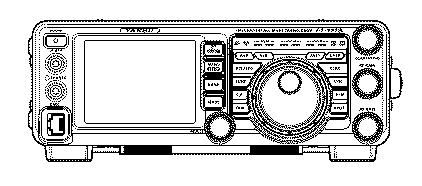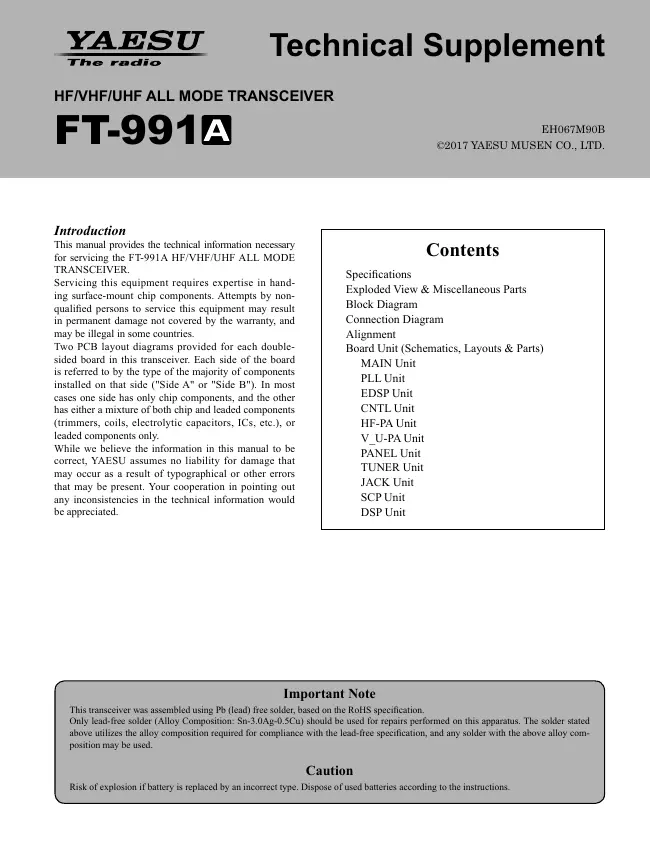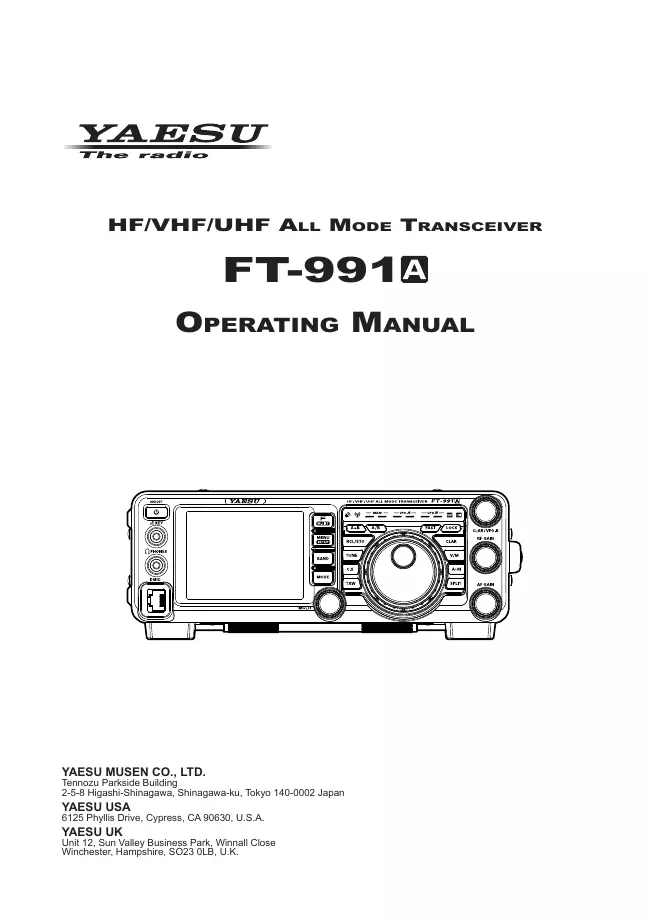Yaesu - FT-991A - Transceiver
Manufacturer:

Image 1 of 2
If you have any other photos or manuals for the
Yaesu FT-991A
you can
upload the files here.
Equipment:
FT-991A
Date:
2015
Category:
Group:
Sub Group:
Information
Built-in high-brightness TFT full-color
display with touch-panel functionality
The FT-991A is equipped with a 3.5 inch full-color TFT
display. Functions, including the receiving band, the noise
and signal interference reduction tools are graphically
displayed. Even while performing rigorous operations,
during DX pditions or contests, the operator may instantly
grasp the status of each function.
Equipped with C4FM digital mode
This transceiver C4FM mode provides good error cor-
rection performance, and supports the V/D mode (voice/
data simultaneous transmission mode) which makes the
transceiver suitable for mobile communication, and the
Voice FR mode (voice full rate mode) which allows the
transceiver to transmit high quality digital audio. The AMS
function recognizes the contacting stations transmission
method and automatically switches the transceiver to the
same C4FM digital or analog (FM) communications mode
as the received signal.
DG-ID (Digital Group ID) feature,
the Group Monitor (GM) feature
enables automatically locating, and
communicating with other stations that
have the same DG-ID number within
contact range.
The two-digit DG-ID numbers (00 to 99) can be set
separately for Transmit and Receive. By setting both
transmit and receive to “00”, communication with all
the other stations in the digital C4FM mode is possible,
regardless of their DG-ID number setting. Matching the
transmit DG-ID number to the uplink DG-ID number set
in the DR-2X System Fusion II digital repeater, will permit
access to the digital repeater DR-2X used by the club.
DP-ID (Digital Personal ID) feature may
communicate only by the transceivers
registered the individual ID information.
Every C4FM digital transmit communication contains
the individual ID information (Radio ID) of each
transceiver. The DP-ID function uses this individual ID
information. When the DP-IDs of the transceiver are
registered with each other, they can communicate even
if the DG-ID numbers are different. By registering the
DP-ID of the transceiver to the DR-2X System Fusion II
digital repeater, the digital repeater may be controlled by
remote operation.
GM (group monitor) function
automatically inquires to find if there
are any stations with the GM function in
operation on the same frequency within
communication range. The members
may then automatically exchange (send/
receive) station location information.
The transceiver automatically checks the channel fre-
quency for registered member stations that are within com-
municating range. The distance and direction information
of the call sign members of the group may be shown on
the TFT display.
Comes equipped with two types of
roofing filters
This transceiver is equipped with two types of roofing fil-
ters for 3 kHz and 15 kHz bandwidths. These narrow band
filters are especially useful on a very crowded band during
contests, because they can dramatically attenuate powerful
out-of-band signals in the first IF stage and reduce their
impact in the second stage to further optimizing the excel-
lent dynamic range and IP3 characteristics for processing
signals ranging from faint to powerful.
Two selectable RF amplifiers provide the
optimal receiver gain for each low-to high
HF band (see page 48.)
Configure the front end RF circuitry for the precise gain and
performance to suit the conditions of each HF band.Select
the IPO (Intercept Point Optimization) feature to optimize
the proximal multi-signal and mutual modulation character-
istics in order to minimize the effects of powerful broadcast
stations, especially in the low-band so that even the faintest
signals can be received. When higher gain is advantageous,
select the single low noise RF amplifier AMP1. In the high
bands, adding AMP2 provides maximum useful gain.
High stability built-in TCXO
The 30.225 MHz standard oscillator provides exceptional
frequency stability. It is temperature compensated and boasts
an enhanced ±0.5 ppm stability from −10°C to +50°C.
WIDTH feature and continuously variable
bandwidth SHIFT feature. Optimal wide to
narrow bandwidth switching (see pages
51, 52.)
The SHIFT feature, can eliminate interference in one side
of the passband. The WIDTH feature allows the bandwidth
to be narrowed by rotating the WIDTH knob. The moment
weak signals disappear due to interfering signals (includ-
ing pile-ups), you can eliminate the interfering signals and
extract only the desired signal, thanks to the unique DSP
sharp filtering characteristic.
CONTOUR feature is renowned for
effective noise control (see page 50.)
Rather than using the DSP extremely sharp attenuation
characteristics, the CONTOUR circuit provides gentle
shaping of the DSP passband filter and can thus attenuate
or peak bandwidth components in segments. The interfer-
ing signal can be naturally shaped without having part of
the signal suddenly interrupted. The contour function is
very effective in making the desired signal rise out of the
interference.
DNR (Digital Noise Reduction) by DSP
digital processing (see page 56.)
The incorporated digital noise reduction circuit may be
set to the optimal working point by varying the 15 step
parameters according to the noise type.
NOTCH feature that significantly
eliminates unwanted beat signals; and
DNF feature that instantly attenuates
multiple beat signals (see page 56.)
When interfering beat signals are present in the receiver
passband, the IF NOTCH feature can significantly elimi-
nate a part of the passband and remove the beat signal.
Moreover, the function is equipped with an Automatic
Tracking System DNF (Digital Notch Filter) that can
be engaged by DSP when there are multiple interfering
signals, even when the frequency is changing.
Reliable High-output Final Amplifier
Stage
In the HF/50MHz frequency range, a pair of RD100HHF1
transistors in a push-pull RF amplifier arrangement deliv-
ers 100 watts of low-distortion, high-quality transmitter
power. The final amplifier for the 144 MHz/430 MHz
bands uses the high-output RDH70HUF2 device, provid-
ing ample output power of 50 watts.
Microphone Amplifier that includes
Parametric Equalizer (see page 65.)
The microphone amplifier equalizer feature is equipped
with a three-stage parametric equalizer that can alter the
Low, Mid, and High frequencies of the audio separately;
this feature permits the bandwidth and gain for each part of
the audio spectrum to be precisely adjusted independently.
Real-Time Spectrum Scope and Multi-Color
Waterfall Display (see page 42.)
The spectrum scope function provides a visual display of
the strength and distribution of signals across the band in
real time. The Waterfall Display Mode portrays color dif-
ferentiation between strong and weak signals.
High speed antenna tuner (see page 63.)
The transceiver is equipped with the relay switching high
speed digital tuner which supports 1.8 MHz to 50 MHz.
The large 100-channel tuning data memory allows im-
mediate recall of the optimum matching conditions for
previously tuned frequencies.
Optional Five Channel Message Memory
(voice memory) (see page 70.)
You can use the 5 channel voice memory function which
is useful for operating in contests, etc. This voice memory
enables recording of up to 20 seconds of audio for each
message you want to send.
Custom selection (C.S) button (see page 39.)
This feature lets you select any Menu item for one-touch
access via the C.S button.
2 Manuals
Service manual
Manual type:
Service manual
Pages:
131
Size:
23.8 MB
Language:
english
Revision:
Manual-ID:
Date:
January 2017
Quality:
Electronic document, no scan, very well readable.
Upload date:
Jan. 11, 2020
MD5:
a252fe3c-e55a-b232-4bdd-8e449091064b
Uploader:
IU2AJB
Downloads:
1242
User manual
Manual type:
User manual
Pages:
158
Size:
17.3 MB
Language:
english
Revision:
Manual-ID:
Date:
January 2017
Quality:
Electronic document, no scan, very well readable.
Upload date:
Jan. 11, 2020
MD5:
70e870f6-983f-8b2e-91d6-89d01666416b
Uploader:
IU2AJB
Downloads:
878

